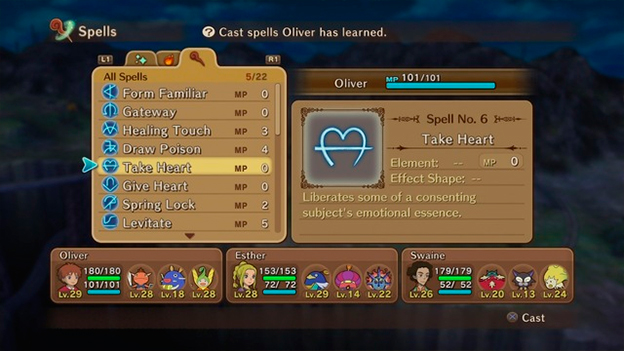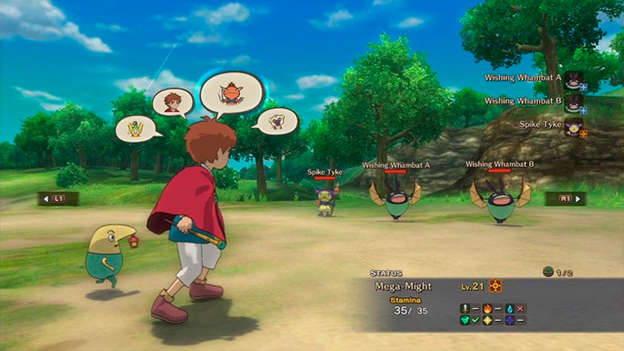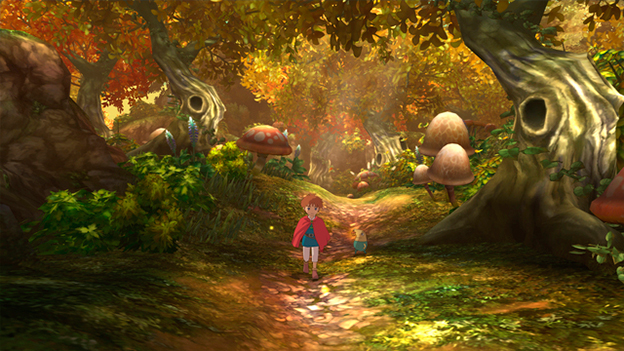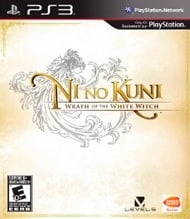Classic Fairy Tale Fantasy At Its Best
In a world full of dark and complex role-playing games, it’s been some time since we’ve seen a simpler kind of game, where good faces off against evil and adventure is accompanied by a sense of wonder. Enter Ni No Kuni: Wrath of the White Witch, a collaboration between veteran RPG developer Level-5 and internationally acclaimed animation house Studio Ghibli. This visually stunning game, with the sensibility of a fairy tale and the scope of an epic quest, is exactly what the doctor ordered.
The star of our story is Oliver, a kindhearted little boy who lives in a city that’s apparently stuck in the halcyon suburban days of the 1950s. When tragedy strikes his family, Oliver’s tears bring his odd stuffed fairy friend, Mr. Drippy, to life. Soon, Oliver is whisked off to Mr. Drippy’s fantastic world and declared to be the “pure-hearted one,” the prophesied savior of a land under siege by the evil djinn Shadar. Oliver decides to become a wizard in order to save both his family and the other world, leading to the adventure of a lifetime.

Oliver and the friends he makes in Ni No Kuni aren’t terribly complex characters, but that’s not the point of this kind of fantasy story. Our heroes are very determined and likeable characters who want to do the right thing for the world, each in their own way. They’re facing off against far greater and more powerful evil forces than they can imagine, and we want to guide them to victory because they’re genuinely good people.
What makes the game’s black-and-white story work is the incredible world dreamed up by Studio Ghibli’s artists and animators. Every area of the game, from the sweeping overworld to the dazzling cities, possesses a lush and dreamlike quality. Ghibli’s mastery of animated fantasy is fully on display here, and playing Ni No Kuni feels like stepping into a movie like My Neighbor Totoro or Spirited Away . All the traditional fantasy game ecosystems (pastoral forest, desert, volcano, frozen kingdom) are here, but they’re given interesting visual and cultural twists that make them feel fresh and worth exploring.

The unusual characters and bizarre creatures that populate the world are brought to life with cel-shaded animation. They don’t completely fit in with the game’s non-cel-shaded environments, but the sheer beauty of it all causes that distinction to rapidly fade away. The subtle shading found on the models is impressive—just watch it play across Oliver’s red cloak as he moves. The whimsical animations possessed by the characters and monsters bring their personalities to life, reminding us that a moving picture can be worth a million words in terms of character expression.
The icing on the cake is the musical score, composed by one of Ghibli’s finest and performed by the Tokyo Philharmonic Orchestra. It’s quite simply the best video game score I’ve heard in years, featuring one stirring piece after another and giving texture and a truly cinematic feel to the world. Ni No Kuni’s sound effects and (somewhat sparse) voice acting are also quite well done, but it’s the music that will really blow players away.
This being a role-playing game, there’s far more to it than a stunning world and heartwarming story. Level-5 steps in here, developing a deceptively deep combat system with complexity that unfolds as the game progresses. There are lots of nasty beasts in Drippy’s world, all of them spoiling for a fight. As Oliver and his young companions aren’t physically powerful, the majority of the combat is performed by familiars, creatures formed from the power of a wizard’s heart or befriended on the battlefield.

Combat is a mix of real-time and turn-based, with action that pauses to allow the player to make decisions when a combat option is selected. Each character in Oliver’s party can choose between three familiars to send into battle, and familiars have a stamina gauge that depletes over time. This means that the familiars will need to be swapped around during longer battles. Human characters can also be swapped to in order to cast spells or use items, but their physical attacks are fairly underwhelming and it’s not a good idea to let monsters bash them for very long.
There are many different kinds of familiars, each with different offensive and defensive capabilities. Some are good physical attackers, while others excel at magic. Of course, enemies have various strengths and weaknesses, with colored numbers providing a quick guide as to whether your attacks are normal, weak, or strong against them. Defense is more interesting—do you want a familiar who can defend slowly against massive enemy attacks, one who can quickly evade them (requiring better timing than defending), or one that can psych up and go wild on the opponent, possibly canceling the special attack from being executed in the first place?
Although it’s generally engaging, there are weaknesses to the combat system. The player is expected to react to enemy tells quickly with a defensive move, but needs to flip through menus in real time in order to select that move. There’s no way to interrupt an attack or spell in progress, either, so the player can expect to eat a certain number of dangerous enemy attacks during difficult battles. Soon after acquiring a full party of three characters, the player gets the ability to tell everyone to defend using the square button, which helps the A.I. characters but not necessarily the player.
There are holes in the A.I. as well. Though the player can assign tactics to the A.I.-controlled characters and can freely swap between characters in battle, the tactics aren’t very customizable. I was never able to find a sweet spot between “don’t use any abilities” and “drain all your magic points within thirty seconds,” and MP-regenerating items are too expensive to pop on a regular basis. This leads to the need to play conservatively when entering a new area, sticking close to an inn or restoration point until the characters are strong enough to mop the floor with the area’s enemies.
Overall, though, there’s some nice depth and challenge in the system, and players can always choose to grind a bit in order to overcome tough enemies if their menu-flipping skills aren’t quite up to the challenge. The game does a good job of warning the player when something particularly deadly is coming up, and there’s always the chance to save the game in case a bit more powering-up is necessary. The density of encounters can feel overwhelming at first, but is mitigated by the fact that weak monsters will flee from the party, allowing older areas to be explored without fear of molestation.
Many players will become addicted to the Pokémon-style system of collecting and evolving familiars. Every species of familiar has three evolutions, the last of which allows the player to choose between two possible final forms. Familiars return to level one with each evolution, but with far more powerful base statistics every time. On top of the evolution system, familiars will need to be equipped with various weapons, armor, and accessories, and they can be fed treats in order to increase their statistics and their overall effectiveness in battle. It can become quite addictive, enough so that I’d recommend sticking with a few favorites rather than attempting to catch and raise them all.

As in all of Level-5’s RPGs, there are tons of extra activities to be undertaken between following the main quest and battling monsters. Ni No Kuni has a great system of side quests that involves a nice variety of activities. The most unique of these is Oliver’s ability to restore people whose hearts have been broken by the evil Shadar. Each of these people has had a particular virtue drained from them, causing their lives to lose direction. Those missing enthusiasm become lethargic, those missing kindness become mean, etc. Oliver has a magic locket that stores these virtues, which he can borrow from people who have an excess of them and use to cure the broken-hearted. Helping out these broken-hearted people is a major theme in the game’s storyline as well as in the side quests, and there’s something particularly satisfying about assisting people in this way.
Other side systems such as alchemy and gambling are more standard-issue, but many are enhanced by the wonderful Wizard’s Compendium that Oliver carries with him. The Compendium contains exhaustive information about the world, and is occasionally required reading in order to complete quests. It has quite a few missing pages that are filled in during the adventure, giving Oliver access to new spells, alchemical formulas, and even fanciful fables that flesh out the story of the world. The player can browse it like a PDF document, though the lack of a physical version means that sometimes one will need to pull out the good old scrap paper in order to take notes. The Compendium just adds a certain something to the game, making it feel like a true wizard’s quest in a living, breathing world.
With the combination of its amazing production values, fairy tale story, and deep RPG systems, Ni No Kuni has all the makings of a classic. It reminds me of book series like Harry Potter and The Chronicles of Narnia that are aimed at kids but appreciated by people of all ages. Parents who remember playing games like Final Fantasy and The Legend of Zelda when they were young will find this the perfect game to play with their kids. The ESRB may have rated it for ages ten and up, but most parents should find it perfectly acceptable for younger elementary students, especially with the assistance of an adult or older sibling.
Ni No Kuni easily stands with the best Japanese RPGs of this generation, and I believe it will stand the test of time to become one of the beloved adventures that people remember for years to come. This is the game for everyone who wishes they made RPGs like they did “back then,” but who also loves the advancements we’ve seen in graphics, sound, and gameplay systems over the years. This collaboration between the world of video games and cinema has turned out a magical game guaranteed to catch the attention and warm the hearts of all but the most jaded gamers.
RATING OUT OF 5 RATING DESCRIPTION 5.0 Graphics
Studio Ghibli’s backgrounds and character animations are simply perfection. 3.8 Control
The battle system is deep and challenging, but could use a few refinements to be truly great. 4.8 Music / Sound FX / Voice Acting
Quite simply the best musical score around, backed up with quality effects and voice acting. 5.0 Play Value
An epic adventure that appeals to all ages, with deep RPG systems that will keep you playing for hours on end. 4.8 Overall Rating – Must Buy
Not an average. See Rating legend below for a final score breakdown.
| Review Rating Legend | |||
|---|---|---|---|
| 0.1 – 1.9 = Avoid | 2.5 – 2.9 = Average | 3.5 – 3.9 = Good | 4.5 – 4.9 = Must Buy |
| 2.0 – 2.4 = Poor | 3.0 – 3.4 = Fair | 4.0 – 4.4 = Great | 5.0 = The Best |
Game Features:
